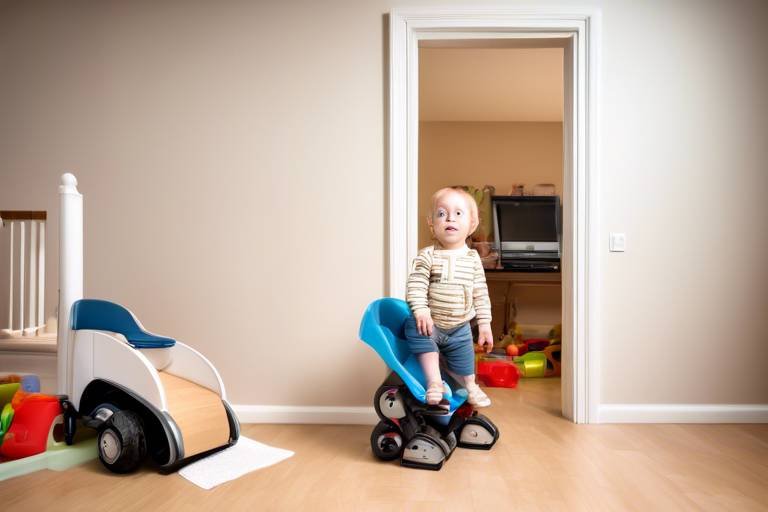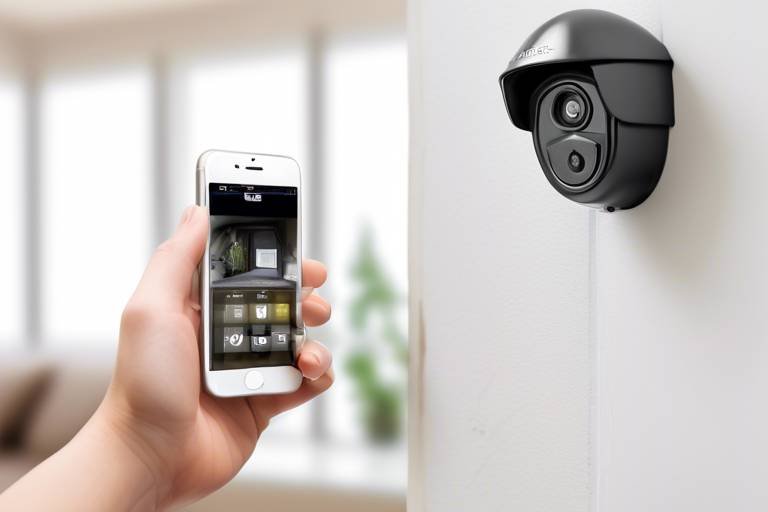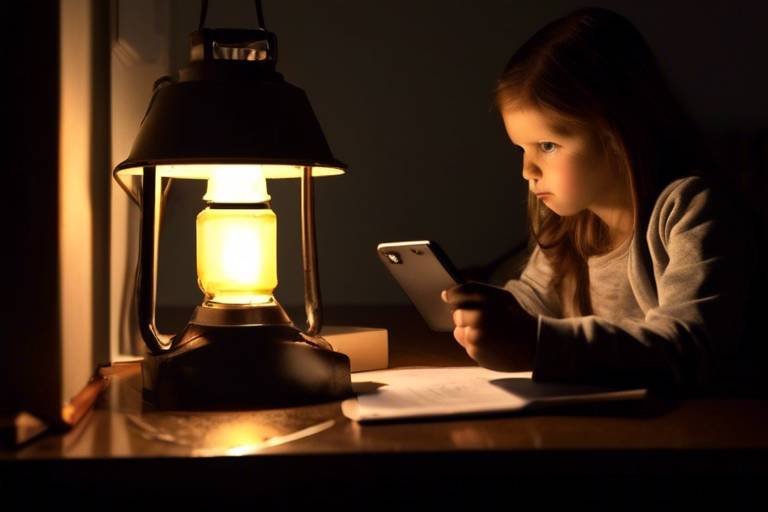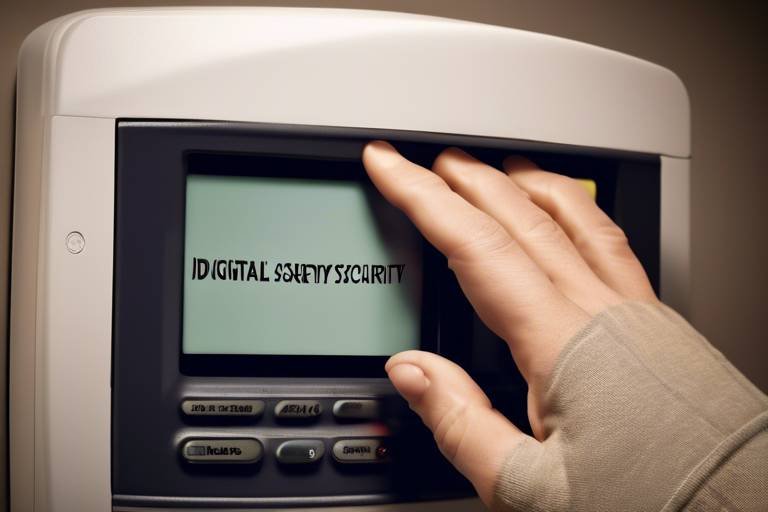How to Childproof a Home for the Mobility Stage
This article provides essential tips and strategies for making your home safe for children who are beginning to crawl and explore, ensuring a secure environment for their development. As your little one embarks on this exciting journey of mobility, the world will suddenly seem vast and full of wonders. However, with this newfound freedom comes the responsibility of keeping them safe. It's like letting a bird out of its cage; you want them to fly, but you also want to ensure they don't fly into a window! So, let’s dive into how to make your home a safe haven for your adventurous crawler.
The mobility stage typically begins around 6 to 10 months of age, when babies start crawling. This stage requires parents to understand the risks associated with increased movement and exploration. Imagine your child as a tiny explorer, ready to uncover every nook and cranny of your home. With this curiosity, however, comes the potential for mishaps. Your home, once a cozy sanctuary, can quickly turn into a labyrinth of hazards if not properly prepared. It’s crucial to stay one step ahead and anticipate what might catch their eye—and their little hands!
Before childproofing, it's crucial to identify potential hazards. This includes sharp edges, electrical outlets, and small objects that could pose choking risks to a curious child. Think of your home as a treasure chest—while there may be beautiful things inside, there are also hidden dangers that need to be addressed. Here’s a closer look at common hazards:
Furniture can be a significant danger for mobile infants. Use corner protectors and ensure heavy furniture is anchored to prevent tipping, reducing the risk of injury from falls. It’s like putting a helmet on a cyclist; it adds an extra layer of protection. Here are some tips to consider:
- Install corner guards on tables and low furniture.
- Anchor bookshelves and cabinets to the wall.
- Keep furniture away from windows to prevent climbing hazards.
Heavy items like bookshelves and televisions should be secured to walls. This prevents tipping accidents that can occur when children pull themselves up on furniture. Imagine a toddler trying to stand up using a bookshelf for support—if it tips, it can lead to serious injuries. Always ensure these items are safely anchored.
Ensure that sharp objects, such as scissors or knives, are stored out of reach. Use drawer locks to keep dangerous items safely enclosed and inaccessible to little hands. Think of it as putting away the tools of a craftsman; they may be useful, but they can also be dangerous in the wrong hands!
Electrical outlets are a major concern for crawling infants. Use outlet covers and ensure cords are secured to prevent children from pulling or chewing on them. Just like a curious cat, babies are drawn to anything that looks like it could be fun to play with. Protecting them from electrical hazards is paramount. Here are some effective strategies:
- Cover all outlets with safety plugs.
- Secure cords using cord organizers or clips.
- Keep electrical devices out of reach.
Designate specific areas for play that are free from hazards. Use playpens or gates to create safe zones where children can explore without danger. Think of these areas as little islands of safety amidst a sea of potential hazards. By creating a safe play area, you allow your child to explore freely while keeping them out of harm's way.
Select age-appropriate toys that do not have small parts. Regularly inspect toys for wear and tear to ensure they remain safe for your child to use. It’s like choosing the right equipment for a sport; the right gear can make all the difference in keeping your child safe while they play.
Even in a childproofed environment, constant supervision is essential. Parents should always keep an eye on their mobile children to prevent accidents and ensure safety. It’s a bit like being a lifeguard at a pool; no matter how safe the environment seems, vigilance is key to preventing accidents.
Q: When should I start childproofing my home?
A: It's best to start childproofing as soon as your baby begins to crawl, typically around 6 to 10 months of age.
Q: What are the most common hazards in a home?
A: Common hazards include sharp furniture edges, electrical outlets, small objects that can be swallowed, and heavy furniture that can tip over.
Q: How can I create a safe play area?
A: Use playpens or baby gates to designate a safe area free from hazards, and ensure the space is stocked with age-appropriate toys.
Q: How often should I inspect toys for safety?
A: Regularly inspect toys, at least once a month, to check for wear and tear and ensure they are safe for your child.

Understanding the Mobility Stage
This article provides essential tips and strategies for making your home safe for children who are beginning to crawl and explore, ensuring a secure environment for their development.
The mobility stage typically begins around 6 to 10 months of age, marking an exciting yet challenging time for both babies and parents. During this phase, babies start to crawl, which opens up a whole new world of exploration. Just imagine your little one, once content to stay in one spot, now zipping around the house like a tiny explorer on a mission! While this newfound mobility is thrilling, it also comes with its own set of risks. You might be wondering, what exactly should I be on the lookout for? Well, as your baby begins to move, they will likely encounter various hazards that could lead to accidents.
Understanding the mobility stage is crucial for parents. It’s not just about watching your child crawl; it’s about anticipating their needs and potential dangers. Babies are naturally curious, and as they navigate their environment, they will reach for anything within their grasp. This includes items that may seem harmless to adults but are actually dangerous for little hands. For example, a shiny piece of jewelry might catch their eye, or a power cord might seem like a fun toy to tug on. Therefore, it’s essential to create a safe space where your child can explore without constant worry.
During this stage, babies learn through movement. They develop their muscles and coordination, which is vital for their physical development. However, this exploration can lead to unexpected situations. Here are some key points to consider:
- Curiosity is Boundless: Babies are innately curious and will investigate everything they can reach.
- Increased Risk of Falls: As they crawl and pull themselves up, the risk of falls increases significantly.
- Choking Hazards: Small objects that are easily overlooked can pose serious choking risks.
To ensure a safe environment, it’s important to stay one step ahead of your child. Regularly assess your home for potential hazards, and consider how your child’s mobility will change their interactions with their surroundings. Think of your home as a dynamic landscape that needs constant monitoring and adjustment. Just like a gardener tends to their plants, nurturing them while ensuring they grow in a safe environment, you too must cultivate a safe space for your child to thrive.
In conclusion, understanding the mobility stage is about embracing the changes that come with your child’s development while being vigilant about safety. The joy of watching your baby explore their world is unparalleled, but it requires a proactive approach to ensure their safety. By anticipating their needs and potential hazards, you can create an environment that fosters exploration while minimizing risks.
Before childproofing, it's crucial to identify potential hazards. This includes sharp edges, electrical outlets, and small objects that could pose choking risks to a curious child.
Furniture can be a significant danger for mobile infants. Use corner protectors and ensure heavy furniture is anchored to prevent tipping, reducing the risk of injury from falls.
Heavy items like bookshelves and televisions should be secured to walls. This prevents tipping accidents that can occur when children pull themselves up on furniture.
Ensure that sharp objects, such as scissors or knives, are stored out of reach. Use drawer locks to keep dangerous items safely enclosed and inaccessible to little hands.
Electrical outlets are a major concern for crawling infants. Use outlet covers and ensure cords are secured to prevent children from pulling or chewing on them.
Designate specific areas for play that are free from hazards. Use playpens or gates to create safe zones where children can explore without danger.
Select age-appropriate toys that do not have small parts. Regularly inspect toys for wear and tear to ensure they remain safe for your child to use.
Even in a childproofed environment, constant supervision is essential. Parents should always keep an eye on their mobile children to prevent accidents and ensure safety.
Q: At what age does the mobility stage typically begin?
A: The mobility stage usually starts around 6 to 10 months of age.
Q: How can I identify hazards in my home?
A: Look for sharp edges, small objects, and areas where heavy furniture can tip over. Regularly assess your home as your child grows.
Q: What are some effective ways to create safe play areas?
A: Use playpens or baby gates to designate safe zones, and ensure these areas are free from any potential hazards.

Identifying Hazards in Your Home
Before diving into the world of childproofing, it's essential to take a step back and assess your home for potential hazards. Think of your home as a treasure chest for your little explorer, but with a few hidden dangers lurking around. When your child begins to crawl, they become a curious adventurer, eager to discover everything within reach. However, this newfound mobility comes with risks that parents must address to ensure a safe environment.
Start by looking around your living space with fresh eyes. What seems harmless to you might be a dangerous obstacle for a crawling infant. Here are some common hazards to consider:
- Sharp Edges: Furniture, such as coffee tables and TV stands, often have sharp corners that can pose a risk of injury. Consider using corner protectors to soften these edges, making them less threatening to tiny heads and bodies.
- Electrical Outlets: These are like tempting little doors to danger. Babies are naturally curious and may try to poke their fingers or toys into outlets. Installing outlet covers is a straightforward solution to keep those little fingers safe.
- Small Objects: Toys, coins, and other small items can easily become choking hazards. Conduct a thorough sweep of your home to ensure that everything within reach is safe for your child.
As you assess your home, remember that the living room is just the beginning. Explore every nook and cranny, including:
| Room | Common Hazards | Safety Tips |
|---|---|---|
| Kitchen | Sharp knives, hot surfaces, small appliances | Use cabinet locks and keep dangerous items out of reach. |
| Bathroom | Medications, cleaning supplies, slippery floors | Store all products in locked cabinets and use non-slip mats. |
| Bedroom | Heavy furniture, cords from blinds | Secure furniture to the wall and keep cords out of reach. |
By taking the time to identify these hazards, you can create a safer environment for your child to explore. The goal is to minimize risks and allow your little one to navigate their world with confidence. Remember, childproofing is not a one-time task; it requires ongoing vigilance as your child grows and their abilities change. So, keep your eyes peeled, and don't hesitate to make adjustments as necessary!

Furniture and Sharp Edges
As your little explorer begins to crawl and navigate the world around them, it's essential to take a closer look at the furniture in your home. Believe it or not, those seemingly harmless coffee tables and bookshelves can turn into significant hazards for a child on the move. It's like having a mini obstacle course right in your living room, but instead of fun, it can lead to tears and injuries. Therefore, paying attention to sharp edges and heavy furniture is crucial for ensuring your child's safety.
First, let's talk about those sharp edges. You know, the ones that seem to jump out at you the moment you least expect it? Coffee tables, side tables, and even the corners of cabinets can be dangerous for little ones who are still mastering their balance. To mitigate these risks, consider investing in corner protectors. These little foam or rubber guards can easily stick onto the edges of your furniture, providing a soft barrier that can cushion any accidental bumps. Trust me, your child will thank you later when they don't have to deal with a painful bruise from a sharp corner!
Next, we can't overlook the potential danger posed by heavy furniture. It's common for children to pull themselves up on furniture as they learn to stand and walk. However, this can lead to tipping accidents if the furniture isn't secured properly. Imagine your child grabbing onto a bookshelf filled with books and toys, only for it to come crashing down. To prevent this nightmare scenario, it's important to anchor heavy items to the wall. Use brackets or straps designed for this purpose, which can be easily installed to keep your furniture stable and secure.
Additionally, when considering furniture safety, think about the layout of your home. If possible, arrange furniture in a way that creates a clear path for your child to crawl and explore. This can help minimize the risk of collisions with sharp edges or heavy items. Remember, a well-organized space can be both functional and safe!
In summary, childproofing your home involves more than just hiding dangerous items; it requires a proactive approach to creating a safe environment. By using corner protectors and securing heavy furniture, you can significantly reduce the risk of injury. Your home should be a place where your child feels free to explore, learn, and grow without the constant worry of sharp edges and falling furniture. So take a moment to assess your space and make those necessary adjustments—your little adventurer deserves a safe playground!
- What are corner protectors, and where can I buy them?
Corner protectors are soft guards that can be attached to sharp furniture edges. They can be purchased at baby stores, online retailers, or home improvement stores. - How do I secure heavy furniture to the wall?
You can use brackets or safety straps specifically designed for securing furniture. Follow the manufacturer's instructions for installation, and ensure they are anchored to a stud in the wall for maximum safety. - At what age should I start childproofing my home?
It's best to start childproofing your home as soon as your baby begins to crawl, which is typically around 6 to 10 months of age.

Securing Heavy Items
When it comes to creating a safe environment for your little explorer, securing heavy items is not just a precaution; it’s a necessity. Imagine your child, full of curiosity and energy, using a bookshelf as a climbing frame. The last thing you want is for that shelf to tip over, turning a moment of innocent play into a potential disaster. To prevent such accidents, it’s crucial to anchor heavy furniture to the walls. This simple step can make a world of difference in ensuring that your home is a safe haven for your child.
Start by identifying the heavy items in your home. This typically includes:
- Bookshelves
- Televisions
- Dressers
- Heavy cabinets
Once you've identified these items, you can take action. Use sturdy furniture straps or brackets to secure them to the wall. Not only does this prevent tipping, but it also gives you peace of mind knowing that your child can explore without the risk of heavy objects falling over. In fact, many parents find that investing in anti-tip kits is a small price to pay for the safety of their children.
Moreover, it’s not just about securing furniture; it’s also essential to consider the placement of heavy items. For instance, avoid placing heavy objects on top of unstable furniture or on shelves that are too high for your child to reach. Instead, keep heavier items lower and out of reach, which minimizes the risk of accidents. Remember, a little foresight today can save you from a world of worry tomorrow.
In addition to securing furniture, consider the overall layout of your rooms. Ensure that pathways are clear and that there are no obstacles that could cause your child to trip. Keeping heavy items organized and secured not only protects your child but also contributes to a more serene and tidy living space. So, take the time to assess your home and make it as safe as possible for your adventurous little one!
Q1: How can I tell if my furniture is secure enough?
A1: Check if your furniture wobbles or tilts; if it does, it likely needs to be anchored. Use anti-tip kits to secure it to the wall.
Q2: What are the best types of anchors for securing furniture?
A2: Heavy-duty L-brackets or furniture straps are excellent choices. Make sure they are installed correctly according to the manufacturer's instructions.
Q3: Should I remove heavy items from my child's reach?
A3: Yes, it’s advisable to keep heavy items out of reach and ensure that any that cannot be moved are securely anchored.
Q4: Is it necessary to childproof every room in the house?
A4: While it’s essential to childproof areas your child frequently visits, such as the living room and kitchen, every room should be assessed for potential hazards.

Removing Sharp Objects
This article provides essential tips and strategies for making your home safe for children who are beginning to crawl and explore, ensuring a secure environment for their development.
The mobility stage typically begins around 6 to 10 months of age, when babies start crawling. This stage requires parents to understand the risks associated with increased movement and exploration.
Before childproofing, it's crucial to identify potential hazards. This includes sharp edges, electrical outlets, and small objects that could pose choking risks to a curious child.
Furniture can be a significant danger for mobile infants. Use corner protectors and ensure heavy furniture is anchored to prevent tipping, reducing the risk of injury from falls.
Heavy items like bookshelves and televisions should be secured to walls. This prevents tipping accidents that can occur when children pull themselves up on furniture.
As your little explorer begins to crawl and reach for everything in sight, it's vital to remove sharp objects from their environment. Sharp items can be found in various places around your home, from the kitchen to the office. Imagine a curious child reaching for a shiny knife or a pair of scissors—this scenario can lead to serious injuries. To prevent such accidents, consider the following:
- Store sharp utensils out of reach: Keep knives, scissors, and other sharp objects in high cabinets or drawers that are not accessible to your child.
- Use drawer locks: Installing locks on drawers can keep dangerous items safely enclosed. This is especially important in kitchens and bathrooms where sharp tools are often found.
- Regularly check for hazards: Make it a habit to inspect your home for any sharp objects that may have been overlooked. Items like broken glass or even sharp toys should be promptly removed.
Additionally, consider using protective covers for sharp table corners and edges. These simple additions can significantly reduce the risk of injury when your child is exploring their surroundings. Remember, a vigilant approach to removing sharp objects can create a safer environment for your little one to grow and thrive.
Electrical outlets are a major concern for crawling infants. Use outlet covers and ensure cords are secured to prevent children from pulling or chewing on them.
Designate specific areas for play that are free from hazards. Use playpens or gates to create safe zones where children can explore without danger.
Select age-appropriate toys that do not have small parts. Regularly inspect toys for wear and tear to ensure they remain safe for your child to use.
Even in a childproofed environment, constant supervision is essential. Parents should always keep an eye on their mobile children to prevent accidents and ensure safety.
Q: When should I start childproofing my home?
A: It's best to start childproofing your home as soon as your baby begins to crawl, typically around 6 to 10 months of age.
Q: What are the most common hazards to look out for?
A: Common hazards include sharp objects, electrical outlets, heavy furniture, and small items that could pose choking risks.
Q: Are there specific products I should buy for childproofing?
A: Yes, consider purchasing corner protectors, outlet covers, drawer locks, and safety gates to help secure your home.
Q: Should I still supervise my child even after childproofing?
A: Absolutely! Constant supervision is essential, as no childproofing measure can replace a parent's watchful eye.

Electrical Safety Measures
When it comes to childproofing your home, electrical safety should be at the top of your priority list. As your little one starts to crawl and explore, those electrical outlets and cords can become a source of curiosity—and danger. Imagine your baby, all wide-eyed and adventurous, making a beeline for that shiny electrical outlet. It’s a common scene, and it’s one that can lead to serious accidents if you're not prepared.
First and foremost, outlet covers are your best friends. These simple devices can be easily installed over outlets to prevent tiny fingers from poking into places they shouldn't. It's like putting a safety lock on a treasure chest; it keeps the precious contents safe from curious explorers. Additionally, consider using tamper-resistant outlets, which are designed to close off access unless pressure is applied simultaneously to both slots. This adds an extra layer of protection against accidental shocks.
Next, let’s talk about cord management. Cords can be a strangling hazard or a tempting chew toy for little ones. To mitigate these risks, secure cords along walls or behind furniture using cord organizers or clips. This not only keeps them out of reach but also reduces clutter, making your living space look tidier. If you have appliances with long cords, try to keep them unplugged when not in use, and store them out of reach. Think of it as putting away the candy jar when the kids are around—you’re just making it harder for them to get into trouble.
In addition to outlet covers and cord management, it's essential to regularly inspect your electrical appliances and outlets for any signs of wear and tear. Frayed cords or damaged outlets can pose serious risks. If you notice any issues, address them immediately—whether that means replacing a damaged cord or calling an electrician to fix an outlet. It’s always better to be proactive than reactive when it comes to safety.
Lastly, consider creating a designated play area away from electrical outlets and cords. This could be a cozy corner filled with toys and soft cushions, where your child can safely explore without the temptation of electrical hazards. By establishing these safe zones, you can give your child the freedom to roam while maintaining peace of mind. Remember, safety is not just about preventing accidents; it’s about creating an environment where your child can thrive.
- What are the best types of outlet covers? Look for tamper-resistant or sliding outlet covers that are difficult for children to remove.
- How can I prevent my child from pulling on cords? Use cord management solutions like clips and ties to keep cords secured and out of reach.
- Is it safe to use extension cords around children? While they can be useful, try to avoid using them as much as possible and ensure they are secured and out of reach.
- What should I do if I find a frayed cord? Replace it immediately or consult a professional to ensure safety in your home.

Creating Safe Play Areas
When it comes to childproofing your home, one of the most important aspects is creating safe play areas for your little explorer. Imagine a world where your child can crawl, roll, and discover without the constant worry of hazards lurking around every corner. This is not just a dream; it can be your reality with a few thoughtful adjustments. Start by designating specific areas in your home that are free from potential dangers. Playpens and baby gates are fantastic tools for this purpose, as they allow your child to roam within a secure environment while giving you peace of mind.
Think about the layout of your home. Is there a room that can be transformed into a play area? Consider using a living room corner or a spacious bedroom. Make sure to remove any breakable items, sharp corners, or small objects that could pose a choking hazard. You want to create an inviting space that encourages exploration but is also safe and secure. Soft rugs or foam mats can be placed on the floor to cushion any falls, making the area even safer for your child.
In your designated play area, choose toys that are not only age-appropriate but also safe. Look for toys that are large enough to prevent choking and are made from non-toxic materials. Regularly inspect these toys for any signs of wear and tear. A broken toy can turn into a hidden danger, so it’s essential to keep everything in check. You might want to create a toy rotation system, where you periodically switch out toys to keep your child engaged while also ensuring that they are playing with safe, intact items.
Furthermore, consider incorporating a few interactive elements into the play area. Things like soft blocks, stuffed animals, and sensory toys can stimulate your child’s development while keeping them entertained. Remember, the goal is to create an environment that is not only safe but also fun and engaging. You want your child to feel free to explore, so make sure the area is well-lit and inviting.
Don’t forget about supervision! Even in a childproofed space, constant monitoring is key. Make it a habit to check in regularly, ensuring that your little one is safe and sound. After all, even the most secure play area can’t replace the watchful eye of a parent. By following these guidelines, you can create a play area that is not only safe but also a delightful space for your child to grow and learn.
- What should I include in a safe play area? Ensure that the area is free of sharp objects, has soft flooring, and contains age-appropriate toys.
- How can I make sure toys are safe? Regularly inspect toys for wear and tear, and choose those without small parts that could pose choking hazards.
- Is supervision really necessary in a childproofed area? Yes, constant supervision is crucial to prevent accidents, even in a seemingly safe environment.

Choosing Safe Toys
When it comes to keeping your little one entertained and safe, selecting the right toys is crucial. As children begin to crawl and explore, they are naturally curious about their surroundings, which includes the toys they play with. But how do you ensure that the toys are not only fun but also safe? First and foremost, look for age-appropriate toys that are designed specifically for your child's developmental stage. This means avoiding toys with small parts that could pose choking hazards. For instance, toys labeled for children aged 0-3 years are generally designed to be larger and safer for infants and toddlers.
Additionally, it’s essential to regularly inspect your child's toys for any signs of wear and tear. Toys that are broken or have sharp edges can quickly become dangerous. If a toy is starting to show its age, it might be time to replace it. You can also consider toys made from non-toxic materials, as babies often explore with their mouths. Check for certifications on the packaging that indicate the toy meets safety standards, such as the ASTM (American Society for Testing and Materials) or CPSC (Consumer Product Safety Commission) labels.
Another tip is to choose toys that encourage creative play and physical activity. Think of building blocks, soft balls, or even plush toys that can withstand a bit of rough handling. These types of toys not only keep your child engaged but also promote their motor skills and cognitive development. You might also want to consider toys that can grow with your child, such as those that can be used in various ways as they grow older.
To help you in your selection process, here’s a quick table summarizing some safe toy options:
| Toy Type | Age Group | Safety Features |
|---|---|---|
| Soft Blocks | 6 months - 2 years | Non-toxic, soft edges |
| Plush Toys | 0 months - 3 years | Machine washable, no small parts |
| Stacking Rings | 6 months - 2 years | Large rings, non-toxic materials |
| Musical Instruments | 1 year - 3 years | Durable, non-toxic finishes |
By choosing safe toys, you’re not just preventing accidents; you’re also setting the stage for a world of imagination and learning. Remember, the best toys are those that challenge your child while keeping them safe. So, the next time you’re out shopping or browsing online, keep these tips in mind, and you’ll be well on your way to creating a safe and stimulating play environment for your little explorer.
Q1: What should I look for when buying toys for my baby?
A1: Look for toys that are age-appropriate, made from non-toxic materials, and free from small parts that could pose choking hazards. Always check for safety certifications on the packaging.
Q2: How often should I check my child's toys for safety?
A2: It's a good practice to inspect toys regularly, especially after playtime. Look for any signs of wear and tear, and replace any broken toys immediately.
Q3: Are there any specific brands known for safe toys?
A3: Many brands focus on safety, such as Melissa & Doug, Fisher-Price, and Hape. Always do your research and check customer reviews for safety feedback.
Q4: Can I use second-hand toys?
A4: Yes, but be sure to thoroughly inspect them for any damage and ensure they meet current safety standards. Avoid toys with small parts or those made from questionable materials.

Monitoring and Supervision
This article provides essential tips and strategies for making your home safe for children who are beginning to crawl and explore, ensuring a secure environment for their development.
The mobility stage typically begins around 6 to 10 months of age, when babies start crawling. This stage requires parents to understand the risks associated with increased movement and exploration. As your little one starts to discover the world around them, they will encounter new challenges that can lead to potential hazards. It’s not just about keeping them safe; it’s about fostering their curiosity in a secure environment.
Before childproofing, it's crucial to identify potential hazards. This includes sharp edges, electrical outlets, and small objects that could pose choking risks to a curious child. The more aware you are of your surroundings, the better equipped you will be to create a safe haven for your little explorer. Remember, what might seem harmless to an adult can be a dangerous temptation for a child.
Furniture can be a significant danger for mobile infants. Use corner protectors and ensure heavy furniture is anchored to prevent tipping, reducing the risk of injury from falls. Think of your home as a mini obstacle course—every corner could be a potential hazard if not properly addressed.
Heavy items like bookshelves and televisions should be secured to walls. This prevents tipping accidents that can occur when children pull themselves up on furniture. It's a simple step that can make a world of difference in keeping your child safe.
Ensure that sharp objects, such as scissors or knives, are stored out of reach. Use drawer locks to keep dangerous items safely enclosed and inaccessible to little hands. A locked drawer might just be the barrier between a fun day and a trip to the emergency room.
Electrical outlets are a major concern for crawling infants. Use outlet covers and ensure cords are secured to prevent children from pulling or chewing on them. A little foresight can prevent a shocking situation!
Designate specific areas for play that are free from hazards. Use playpens or gates to create safe zones where children can explore without danger. Having a dedicated play area allows your child to roam freely while you can relax knowing they are in a secure environment.
Select age-appropriate toys that do not have small parts. Regularly inspect toys for wear and tear to ensure they remain safe for your child to use. Remember, a toy that seems fun can quickly become a safety hazard if it’s not suitable for their age.
Even in a childproofed environment, constant supervision is essential. Parents should always keep an eye on their mobile children to prevent accidents and ensure safety. Think of it as being the captain of a ship; your little one is the adventurous sailor, and it's your job to navigate them through the sometimes turbulent waters of childhood exploration. No matter how secure your home is, nothing replaces the watchful eye of a parent. Here are some tips to enhance your monitoring:
- Stay within arm's reach: When your child is playing, try to be nearby, ready to intervene if necessary.
- Engage in their play: Join them in their activities. This not only keeps them safe but also strengthens your bond.
- Use baby monitors: If you need to step away momentarily, consider using a baby monitor to keep an ear on their activities.
It’s important to remember that even the most vigilant parents can’t predict every fall or stumble. Therefore, having a first-aid kit readily available is a smart move. In the end, your attentiveness can make all the difference in keeping your little one safe as they embark on their exciting journey of mobility.
Common hazards include sharp furniture edges, electrical outlets, choking hazards from small objects, and unstable furniture that can tip over.
Designate a specific area for play, use gates or playpens, and ensure that the space is free from sharp objects and choking hazards. Soft mats can also provide a safe surface for crawling.
Yes! While childproofing is essential, constant supervision is the best way to prevent accidents and ensure your child's safety as they explore their surroundings.
Frequently Asked Questions
- What is the mobility stage in infants?
The mobility stage usually starts around 6 to 10 months when babies begin to crawl and explore their surroundings. This stage is crucial as it opens up a whole new world for them, but it also comes with increased risks that parents need to address.
- How can I identify hazards in my home?
Look for sharp edges on furniture, electrical outlets, and small objects that could be choking hazards. It's all about being proactive; think like a curious little explorer and consider what might catch their attention or pose a danger.
- What are the best ways to secure heavy furniture?
Use furniture anchors to secure heavy items like bookshelves and televisions to the wall. This prevents tipping accidents that can happen when infants pull themselves up on furniture. Safety first, right?
- How do I ensure electrical safety?
Cover electrical outlets with safety covers and secure cords to the wall or furniture to keep them out of reach. Remember, kids are naturally curious, and electrical outlets can look like a fun puzzle to them!
- What should I consider when creating safe play areas?
Designate specific areas for play that are free from hazards. Use playpens or baby gates to create safe zones where your little one can explore without getting into trouble.
- How do I choose safe toys for my child?
Select age-appropriate toys without small parts that could pose choking risks. Regularly inspect toys for wear and tear, ensuring that they remain safe and fun for your child to use.
- Is constant supervision really necessary?
Absolutely! Even in a childproofed environment, constant supervision is essential. Keeping a watchful eye on your mobile child can prevent accidents and ensure they stay safe while exploring.


















